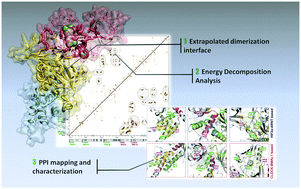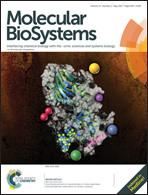Structural modeling of the AhR:ARNT complex in the bHLH–PASA–PASB region elucidates the key determinants of dimerization†
Abstract
Elucidation of the dimerization process of the aryl hydrocarbon receptor (AhR) with the AhR nuclear translocator (ARNT) is crucial for understanding the mechanisms underlying the functional activity of AhR, including mediation of the toxicity of environmental contaminants. In this work, for the first time a structural model of the AhR:ARNT dimer encompassing the entire bHLH–PASA–PASB domain region is proposed. It is developed by using a template-based modeling approach, relying on the recently available crystallographic structures of two dimers of homologous systems in the bHLH–PAS family of proteins: the CLOCK:BMAL1 and the HIF2α:ARNT heterodimers. The structural and energetic characteristics of the modeled AhR:ARNT protein–protein interface are determined by evaluating the variations in solvent accessible surface area, the total binding free energy and the per-residue free energy contributions obtained by the MM-GBSA method and the Energy Decomposition Analysis. The analyses of the intricate network of inter-domain interactions at the dimerization interfaces provide insights into the key determinants of dimerization. These are confirmed by comparison of the computational findings with the available experimental mutagenesis and functional analysis data. The results presented here on the AhR:ARNT dimer structure and interactions provide a framework to start analyzing the mechanism of AhR transformation into its functional DNA binding form.



 Please wait while we load your content...
Please wait while we load your content...